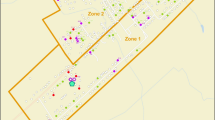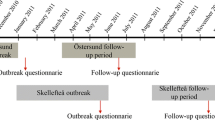Abstract
Background
Following bacterial contamination of a municipal water system in the rural town of Walkerton, Ontario, over 2,300 cases of acute gastroenteritis were documented. The Walkerton Health Study is currently underway to assess for long-term health sequelae among consenting inhabitants of Walkerton, related to the original outbreak. We explored whether the association between the acute exposure and preliminary long-term health outcomes may have been biased through differences between early- and late-recruited study participants.
Methods
Using multiple data sources, including the 1996 and 2001 Canadian Census, and records from the Regional Health Unit, hospital and Walkerton Health Study, we determined both sample representativeness and the anticipated effects of intensifying study participant recruitment. Selection bias was assessed by examining for differences between initial and late participants, and their subsequent risk of having hypertension, proteinuria and reduced renal clearance.
Results
Of the 4,315 participants, 2,756 were permanent residents of Walkerton, representing 55% of the town’s total population. The sample was demographically similar to the population of interest, although statistically women were more likely to participate than men (55% of sample were women compared to 52% of population, p<0.01), and the proportion of both young and very elderly adults was smaller than expected (13% of sample were >65 years of age compared to 18% of population, p<0.01). Comparing the initial 3,959 participants to the 356 persons additionally recruited with substantial effort, the latter were more likely to be free of symptoms during the outbreak (21% vs. 7%, p<0.001), but were otherwise similar in terms of age, sex, the use of medical care resources and underlying health state predating the outbreak. The risk of long-term hypertension or renal sequelae did not significantly differ between initial and late study recruits.
Conclusions
Participants in the Walkerton Health Study represent the population of interest, and comprise those who were acutely ill during the infected water outbreak. The available study sample should provide reasonably unbiased estimates of the associated risk between acute bacterial gastroenteritis and long-term health sequelae.
Résumé
Contexte
Après la contamination bactérienne du réseau municipal d’alimentation en eau de la collectivité rurale de Walkerton, en Ontario, plus de 2 300 cas de gastro-entérite aiguë ont été documentés. L’Étude sur la santé de Walkerton évalue actuellement les séquelles à long terme de cette flambée épidémique sur la santé des habitantes et des habitants de Walkerton ayant accepté de participer. Nous avons cherché à déterminer si l’association entre l’exposition aiguë et les premiers résultats sanitaires à long terme pouvait comporter des biais en raison des différences entre les recrues initiales et tardives.
Méthode
Nous avons utilisé des données de plusieurs sources, dont les recensements canadiens de 1996 et de 2001 et les dossiers de la circonscription sanitaire, de l’hôpital et de l’Étude sur la santé de Walkerton, pour déterminer la représentativité de l’échantillon et les effets escomptés de l’intensification du recrutement. Pour évaluer le biais de sélection, nous avons cerné les différences entre les recrues initiales et tardives et leur risque ultérieur de souffrir d’hypertension artérielle, de protéinurie et de clairance rénale réduite.
Résultats
Des 4 315 personnes participantes, 2 756 étaient des résidents permanents de Walkerton, soit 55 % de la population de la ville. Sur le plan démographique, l’échantillon était semblable à la population de Walkerton, bien que statistiquement, les femmes aient eu plus tendance à participer que les hommes (l’échantillon comportait 55 % de femmes, alors qu’elles représentent 52 % de la population, p < 0,01), et que les proportions de jeunes et de personnes très âgées aient été plus faibles que prévu (l’échantillon comportait 13 % de personnes de plus de 65 ans, alors qu’elles représentent 18 % de la population, p < 0,01). Si l’on compare les 3 959 recrues initiales aux 356 personnes recrutées plus tard au prix d’un effort considérable, ces dernières étaient plus susceptibles d’avoir été asymptomatiques durant la flambée (21 % c. 7 %, p < 0,001), mais sur tous les autres plans (âge, sexe, recours aux soins médicaux et état de santé avant la flambée), les deux groupes étaient semblables. Le risque d’hypertension artérielle ou de séquelles rénales à long terme ne différait pas de façon significative chez les recrues initiales et tardives de l’étude.
Conclusions
Les participantes et les participants de l’Étude sur la santé de Walkerton sont représentatifs de la population de Walkerton, et ils comprennent les personnes atteintes d’infections aiguës durant la flambée d’origine hydrique. L’échantillon disponible pour l’étude devrait donc fournir des estimations raisonnablement impartiales du risque associé entre la gastro-entérite bactérienne aiguë et les séquelles à long terme sur la santé.
Similar content being viewed by others
References
Anonymous. The investigative report of the Walkerton outbreak of waterborne gastroenteritis May–June 2000. Bruce-Grey-Owen Sound Health Unit. 2000;1–67.
Neal KR, Hebden J, Spiller R. Prevalence of gastrointestinal symptoms six months after bacterial gastroenteritis and risk factors for development of the irritable bowel syndrome: Postal survey of patients. BMJ 1997;314(7083):779–82.
Parry SD, Stansfield R, Jelley D, Gregory W, Phillips E, Barton JR, et al. Does bacterial gastroenteritis predispose people to functional gastrointestinal disorders? A prospective, community-based, case-control study. Am J Gastroenterol 2003;98(9):1970–75.
Hannu T, Mattila L, Rautelin H, Pelkonen P, Lahdenne P, Siitonen A, et al. Campylobacter-triggered reactive arthritis: A population-based study. Rheumatology (Oxford) 2002;41(3):312–18.
Bremell T, Bjelle A, Svedhem A. Rheumatic symptoms following an outbreak of campylobac-ter enteritis: A five year follow up. Ann Rheum Dis 1991;50(12):934–38.
Garg AX, Suri RS, Barrowman N, Rehman F, Matsell D, Rosas-Arellano MP, et al. Long-term renal prognosis of diarrhea-associated hemolytic uremic syndrome: A systematic review, meta-analysis, and meta-regression. JAMA 2003;290(10):1360–70.
Suri R, Clark W, Mahon J, Garg AX. Incidence of diabetes mellitus after diarrhea associated hemolytic-uremic syndrome: A systematic review. Submitted for review.
Bertazzi PA. Industrial disasters and epidemiology. A review of recent experiences. Scand J Work Environ Health 1989;15(2):85–100.
Lyons RA, Temple JM, Evans D, Fone DL, Palmer SR. Acute health effects of the Sea Empress oil spill. J Epidemiol Community Health 1999;53(5):306–10.
Ives DG, Traven ND, Kuller LH, Schulz R. Selection bias and nonresponse to health promotion in older adults. Epidemiology 1994;5(4):456–61.
Sheikh K. Predicting risk among non-respondents in prospective studies. Eur J Epidemiol 1986;2(1):39–43.
Statistics Canada Census Operating Division. A profile of the Canadian population: Where we live. Statistics Canada 2004; Catalogue: 96F003XIE0 no1.
Gardner MJ, Altman DG. Statistics with confidence. BMJ 1994;51–52.
Ganguli M, Lytle ME, Reynolds MD, Dodge HH. Random versus volunteer selection for a community-based study. J Gerontol A Biol Sci Med Sci 1998;53(1):M39-M46.
Roht LH, Vernon SW, Weir FW, Pier SM, Sullivan P, Reed LJ. Community exposure to hazardous waste disposal sites: Assessing reporting bias. Am J Epidemiol 1985;122(3):418–33.
Rowland ML, Forthofer RN. Adjusting for non-response bias in a health examination survey. Public Health Rep 1993;108(3):380–86.
Brick JM, Kalton G. Handling missing data in survey research. Stat Methods Med Res 1996;5(3):215–38.
Korkeila K, Suominen S, Ahvenainen J, Ojanlatva A, Rautava P, Helenius H, et al. Non-response and related factors in a nation-wide health survey. Eur J Epidemiol 2001;17(11):991–99.
Van Loon AJ, Tijhuis M, Picavet HS, Surtees PG, Ormel J. Survey non-response in the Netherlands: Effects on prevalence estimates and associations. Ann Epidemiol 2003;13(2):105–10.
Kotaniemi JT, Hassi J, Kataja M, Jonsson E, Laitinen LA, Sovijarvi AR, et al. Does non-responder bias have a significant effect on the results in a postal questionnaire study? Eur J Epidemiol 2001;17(9):809–17.
Brogger J, Bakke P, Eide GE, Gulsvik A. Contribution of follow-up of nonresponders to prevalence and risk estimates: A Norwegian respiratory health survey. Am J Epidemiol 2003;157(6):558–66.
Chou P, Kuo HS, Chen CH, Lin HC. Characteristics of non-participants and reasons for non-participation in a population survey in Kin-Hu, Kinmen. Eur J Epidemiol 1997;13(2):195–200.
de Marco R, Verlato G, Zanolin E, Bugiani M, Drane JW. Nonresponse bias in EC Respiratory Health Survey in Italy. Eur Respir J 1994;7(12):2139–45.
Buchner DM, Pearson DC. Factors associated with participation in a community senior health promotion program: A pilot study. Am J Public Health 1989;79(6):775–77.
Shahar E, Folsom AR, Jackson R. The effect of nonresponse on prevalence estimates for a referent population: Insights from a population-based cohort study. Atherosclerosis Risk in Communities (ARIC) Study Investigators. Ann Epidemiol 1996;6(6):498–506.
Hill A, Roberts J, Ewings P, Gunnell D. Non-response bias in a lifestyle survey. J Public Health Med 1997;19(2):203–7.
O’Neill TW, Marsden D, Silman AJ. Differences in the characteristics of responders and non-responders in a prevalence survey of vertebral osteoporosis. European Vertebral Osteoporosis Study Group. Osteoporos Int 1995;5(5):327–34.
Nakai S, Hashimoto S, Murakami Y, Hayashi M, Manabe K, Noda H. [Response rates and non-response bias in a health-related mailed survey]. Nippon Koshu Eisei Zasshi 1997;44(3):184–91.
Hoeymans N, Feskens EJ, Van Den Bos GA, Kromhout D. Non-response bias in a study of cardiovascular diseases, functional status and self-rated health among elderly men. Age Ageing 1998;27(1):35–40.
Etter JF, Perneger TV. Analysis of non-response bias in a mailed health survey. J Clin Epidemiol 1997;50(10):1123–28.
Foster K, Campbell D, Crum J, Stove M. Non-response in a population study after an environmental disaster. Public Health 1995;109(4):267–73.
Siemiatycki J, Campbell S. Nonresponse bias and early versus all responders in mail and telephone surveys. Am J Epidemiol 1984;120(2):291–301.
Author information
Authors and Affiliations
Consortia
Corresponding author
Rights and permissions
About this article
Cite this article
Garg, A., Macnab, J., Clark, W. et al. Long-term Health Sequelae Following E.coli and Campylobacter Contamination of Municipal Water. Can J Public Health 96, 125–130 (2005). https://doi.org/10.1007/BF03403675
Received:
Accepted:
Published:
Issue Date:
DOI: https://doi.org/10.1007/BF03403675




